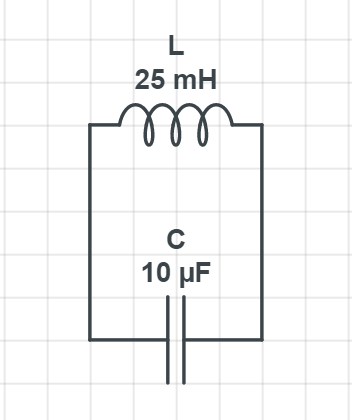
If maximum energy is stored in a capacitor at $t=0$ then find the time after which current in the circuit will be maximum.

\[\begin{align}
& A.\dfrac{\pi }{2}ms \\
& B.\dfrac{\pi }{4}ms \\
& C.\pi ms \\
& D.2ms \\
\end{align}\]

Answer
562.2k+ views
Hint: In a LCR circuit, the inductor $L$, capacitance $C$ and resistance $R$ are connected to a AC source. Here the LCR is connected in series circuit; it can also be connected in parallel circuit. Then the phase difference between the current and the voltage is $\theta$ generally.
Formula used:
$T=2\pi\sqrt{LC}$
Complete step by step answer:
We know that the source of an AC circuit is sinusoidal. Then there is a phase difference between the voltage and current. If the phase difference between the current and voltage is zero, then both are said to be in phase, and if the phase difference is not equal to zero, then both are said to be out of phase. Resonance is a special condition, which is observed when RLC is connected in series; here there is no phase difference between the current and the voltage.
We know that the frequency of the circuit is given as,$\omega=\dfrac{1}{\sqrt{LC}}$
$\implies T=2\pi\sqrt{LC}$, where $T$ is the time-period of one cycle.
Here, we have LC circuit, and given that, $L=25mH$ and $C=10\mu F$, substituting the values, we get,
$T=2\pi\sqrt{25\times 10^{-3}\times 10\times 10^{-6}}$
$\implies T=2\pi\sqrt{25\times 10^{-8}}$
$\implies T=2\pi\times 5\times 10^{-4}$
$\therefore T=\pi\times 10^{-3}s$
Since the AC is sinusoidal in nature and the time-period of the wave is $T=\pi\times 10^{-3}s$, we know that at $\dfrac{T}{4}$, the capacitance discharges the charge stored in it, and thus the current is maximum. Hence at $T_{max}=\dfrac{T}{4}=\dfrac{\pi\times 10^{-3}}{4}$
$\therefore T_{max}=\dfrac{\pi}{4}ms$
So, the correct answer is “Option B”.
Note:
$Z$ is the impedance of the circuit or the total resistance offered by the circuit, it is given as $Z=\sqrt{R^{2}+(X_{L}-X_{C})^{2}}$. Here $X_{L},X_{C}$ are the inductive reactance and the capacitive reactance. Using the frequency of the circuit, we can solve this sum.
Formula used:
$T=2\pi\sqrt{LC}$
Complete step by step answer:
We know that the source of an AC circuit is sinusoidal. Then there is a phase difference between the voltage and current. If the phase difference between the current and voltage is zero, then both are said to be in phase, and if the phase difference is not equal to zero, then both are said to be out of phase. Resonance is a special condition, which is observed when RLC is connected in series; here there is no phase difference between the current and the voltage.
We know that the frequency of the circuit is given as,$\omega=\dfrac{1}{\sqrt{LC}}$
$\implies T=2\pi\sqrt{LC}$, where $T$ is the time-period of one cycle.
Here, we have LC circuit, and given that, $L=25mH$ and $C=10\mu F$, substituting the values, we get,
$T=2\pi\sqrt{25\times 10^{-3}\times 10\times 10^{-6}}$
$\implies T=2\pi\sqrt{25\times 10^{-8}}$
$\implies T=2\pi\times 5\times 10^{-4}$
$\therefore T=\pi\times 10^{-3}s$
Since the AC is sinusoidal in nature and the time-period of the wave is $T=\pi\times 10^{-3}s$, we know that at $\dfrac{T}{4}$, the capacitance discharges the charge stored in it, and thus the current is maximum. Hence at $T_{max}=\dfrac{T}{4}=\dfrac{\pi\times 10^{-3}}{4}$
$\therefore T_{max}=\dfrac{\pi}{4}ms$
So, the correct answer is “Option B”.
Note:
$Z$ is the impedance of the circuit or the total resistance offered by the circuit, it is given as $Z=\sqrt{R^{2}+(X_{L}-X_{C})^{2}}$. Here $X_{L},X_{C}$ are the inductive reactance and the capacitive reactance. Using the frequency of the circuit, we can solve this sum.
Recently Updated Pages
A man running at a speed 5 ms is viewed in the side class 12 physics CBSE

The number of solutions in x in 02pi for which sqrt class 12 maths CBSE

State and explain Hardy Weinbergs Principle class 12 biology CBSE

Write any two methods of preparation of phenol Give class 12 chemistry CBSE

Which of the following statements is wrong a Amnion class 12 biology CBSE

Differentiate between action potential and resting class 12 biology CBSE

Trending doubts
What are the major means of transport Explain each class 12 social science CBSE

Which are the Top 10 Largest Countries of the World?

Draw a labelled sketch of the human eye class 12 physics CBSE

How much time does it take to bleed after eating p class 12 biology CBSE

Explain sex determination in humans with line diag class 12 biology CBSE

Explain sex determination in humans with the help of class 12 biology CBSE




